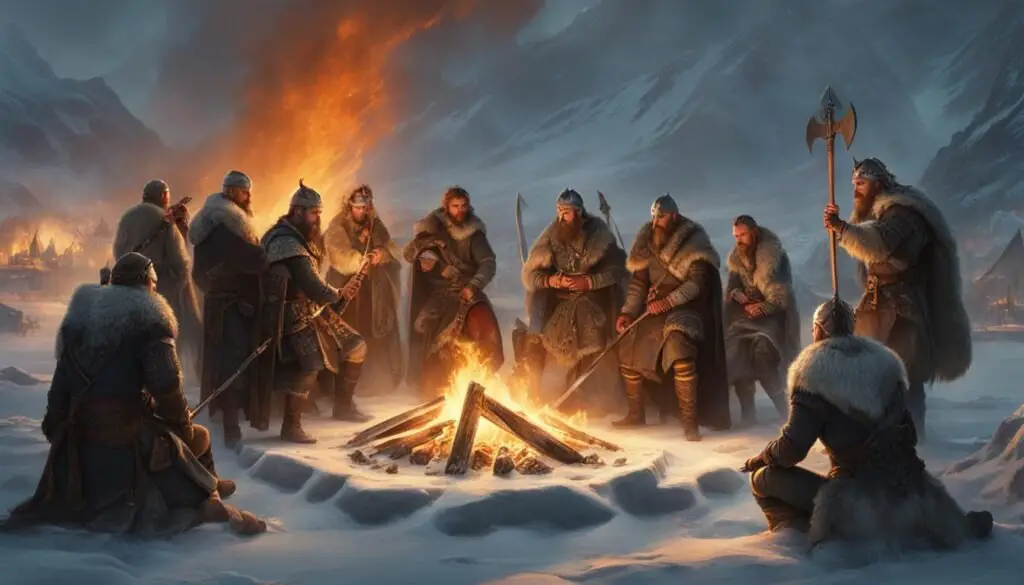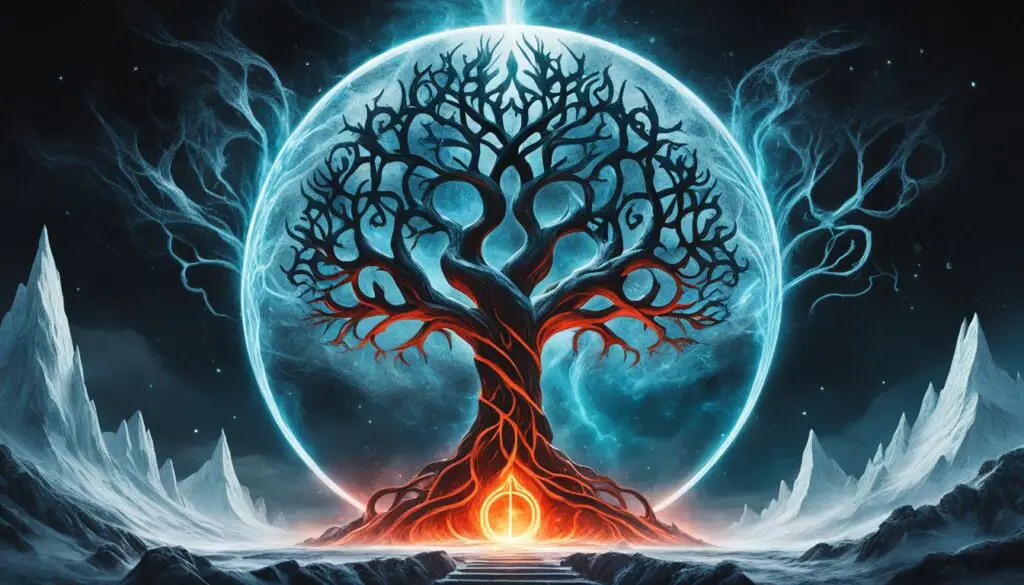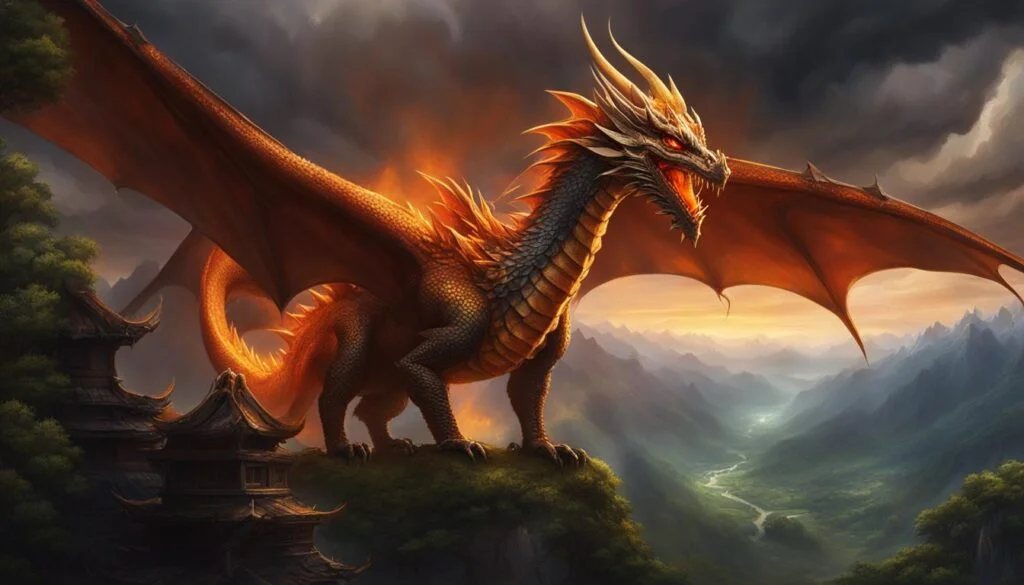Discover the mysterious realm of Niflheim in Norse mythology. As one of the nine realms of the universe, Niflheim holds great significance in Norse cosmology. In this article, we will delve into the meaning, origin, and description of Niflheim, exploring its mythology and its presence in Norse sagas and the Prose Edda. Join us on a journey through this chilling realm and uncover its role in the afterlife and the creation myth.
Key Takeaways:
- Niflheim is one of the nine realms in Norse mythology, known for its cold and icy landscapes.
- The realm is associated with the afterlife and the realm of the dishonored dead, including Helheim and Nastrond.
- Niflheim played a crucial role in the Norse creation myth, as the birthplace of Ymir, the first living being.
- It has a strong connection to the World Tree, Yggdrasil, representing the cycle of life, death, and rebirth.
- Modern interpretations of Niflheim in popular culture may not fully capture its complexities as described in ancient Norse texts.
The Importance of Niflheim in Norse Mythology
Niflheim holds great importance in Norse mythology and religion. It is one of the more thoroughly recorded realms in Norse mythology, highlighting its significance in the Norse worldview.
Niflheim is closely associated with the afterlife, specifically the realm of the dishonored dead. Souls who did not die in battle would find themselves in Niflheim, where they would undergo a process of purification and atonement for their sins. This purification process was considered essential for the soul’s journey in the afterlife.
Furthermore, Niflheim plays a crucial role in the Norse creation myth. It is the birthplace of Ymir, the first living being in Norse mythology. Ymir’s existence marked the beginning of the formation of the cosmos, making Niflheim a significant starting point in the Norse cosmology.
The importance of Niflheim in Norse mythology stems from its association with the afterlife and its role in the creation of the cosmos. It represents a realm of purification and redemption for souls, ensuring their readiness for the afterlife. Additionally, Niflheim’s connection to the creation of the cosmos emphasizes its significance in the Norse understanding of the universe’s origin and structure.
Niflheim – Land of the Dishonored Dead
In Norse mythology, Niflheim is the realm where souls that have met a dishonorable death are consigned. Within Niflheim, there are different areas dedicated to the afterlife, with the majority of souls residing in Helheim. Helheim, ruled by Hel, one of Loki’s children, is often likened to purgatory, a place of purification rather than eternal damnation. Here, souls undergo a transformative process to atone for their sins and cleanse themselves before moving on to other realms.
However, for souls deemed guilty of oath-breaking, murder, or adultery, a far more severe fate awaits them in Nastrond, a dark and nightmarish place within Niflheim. Nastrond is described as a hall constructed from the spines of snakes, symbolizing the severe punishment inflicted upon those who have committed heinous deeds.
Niflheim and the Norse Creation Myth

Niflheim, one of the nine realms in Norse mythology, played a crucial role in the creation myth of the Norse cosmos. According to the myth, at the beginning of time, a vast void known as Ginnungagap existed. From this void, two contrasting realms emerged – Niflheim in the north and Muspelheim in the south. Niflheim was a realm of darkness, ice, and cold, while Muspelheim was a realm of fire.
The clash between these opposing forces caused the formation of the first pool of water known as the Hvergelmir. From the melting ice in Niflheim, emerged Ymir, the first living being in Norse mythology. Ymir was a powerful giant, and he was the progenitor of the Frost Giants.
The story continues with Ymir’s existence being cut short by the gods. Odin, Vili, and Ve, sons of the primordial giant Bor, slew Ymir and used his body to create the world. Ymir’s flesh formed the land, his blood transformed into the ocean, and his bones formed the mountains. From the sparks of Muspelheim, Odin and his brothers created the sun, moon, and stars.
Niflheim’s connection to the creation of Midgard, the realm of mankind, is particularly significant. According to the myth, the gods used Ymir’s eyebrows to create a protective barrier around Midgard, known as Midgard’s enclosure. This enclosure ensured that the realm of humans remained separate from the wild and chaotic realms that existed beyond.
The intricate relationship between Niflheim, Yggdrasil, and the creation myth showcases the complex and interconnected nature of Norse cosmology. Niflheim’s icy presence and its connection to the birth of Ymir emphasize its vital role in the Norse worldview and the cyclical nature of life, death, and rebirth.
Niflheim and Yggdrasil

In Norse mythology, the nine realms were held together by the World Tree, Yggdrasil. Niflheim, one of these realms, had a strong connection to Yggdrasil as its roots were deeply embedded in the icy landscapes of Niflheim.
Yggdrasil, with its base in Midgard and its upper branches reaching Asgard and Vanaheim, symbolized the interconnectedness of the Norse cosmos. It represented the cycle of life, death, and rebirth, while Niflheim represented the realm of death and purification.
The roots of Yggdrasil in Niflheim acted as a bridge between the realm of the living and the realm of the dead. This connection emphasized the cyclic nature of life and death in Norse religion, reaffirming the belief that death was an integral part of the natural order.
Through the intertwining of these two realms, Niflheim and Yggdrasil, the Norse people were reminded of the interconnectedness of all things and the importance of embracing the cycle of life. This connection served as a powerful symbol within the Norse cosmology, highlighting the intricate and complex nature of their belief system.
Niflheim in Modern Interpretations

Niflheim, the chilling realm of Norse mythology, has found its place in modern interpretations of this ancient lore. It has become a popular fixture in various forms of popular culture, including Marvel movies and video games like God of War. These modern depictions often focus on the dark and cold nature of Niflheim, embracing its chilling and mysterious aspects.
Marvel movies, known for their larger-than-life characters and fantastical settings, have incorporated Niflheim into their storytelling. However, it is important to note that these interpretations may not always capture the full complexity of Niflheim as described in ancient Norse texts. In Norse mythology, Niflheim was not simply a monolithic realm of darkness, but rather a nuanced realm with different areas and associations within itself.
Niflheim has also made its mark in the realm of video games. The popular game God of War features Niflheim as one of its locations, presenting players with a treacherous and icy landscape to explore. This depiction adds to the immersive experience of the game and showcases the enduring appeal of Norse mythology.
It is worth mentioning, however, that while these modern interpretations capture the essence of Niflheim’s chilling and mysterious nature, they may not fully represent its depth as recorded in ancient Norse texts. The true nature of Niflheim goes beyond simple darkness and cold, with its associations with the afterlife and the intricate realms within. The richness and complexity of Niflheim in Norse mythology are best explored through a deeper dive into the ancient Norse texts themselves.
In conclusion, Niflheim has become a captivating element in modern interpretations of Norse mythology. Its appearances in Marvel movies and video games like God of War have brought this chilling realm to a wider audience, showcasing its mysterious allure. While these depictions offer a glimpse into Niflheim’s chilling nature, a more comprehensive understanding can be found in the rich descriptions found within ancient Norse texts.
The Positive Views of Niflheim

While Niflheim is often associated with darkness and punishment in modern interpretations, ancient Norse texts presented a more positive view of the realm. Niflheim was considered the repository of all knowledge and held the vast majority of mortal souls. When the gods, especially Odin, sought advice or help, they would often contact the souls in Niflheim. This portrayal highlights the belief that Niflheim contained wisdom and guidance beyond its chilling exterior. It also illustrates the Norse understanding that death was not to be feared but rather a necessary part of the cycle of life and rebirth.
In Norse mythology, Niflheim served as a crucial source of information and insight. It was believed to be the dwelling place of ancestral spirits, making it a valuable repository of knowledge. The souls in Niflheim possessed vast wisdom gained from their experiences in the human realm, and the gods would consult them for guidance in matters of great importance.
This positive view of Niflheim challenges the common perception of the realm as only being associated with darkness and punishment. It demonstrates that Niflheim had a multifaceted nature, encompassing not just the harsh aspects, but also a profound wisdom and enlightenment.
The Connection Between Niflheim and Soul Communication
Communication with the souls in Niflheim was an integral part of Norse mythology and religious practices. It was believed that by tapping into the wisdom of these ancestral spirits, the gods and humans could gain valuable insights and guidance.
Norse mythology holds that the god Odin, known for his relentless pursuit of knowledge, frequently sought the counsel of the souls in Niflheim. Through spiritual rituals and connections to the spirit realm, Odin was able to communicate with the souls and gather their wisdom. This interaction affirmed the positive role of Niflheim as a conduit for soul communication and the exchange of knowledge.
In addition to Odin, other gods and individuals who sought wisdom and guidance from the spiritual realm would turn to Niflheim. The positive views associated with Niflheim in this context highlight its importance as a source of enlightenment and understanding.
The Positive Aspects of Niflheim
Contrary to popular belief, Niflheim in Norse mythology encompassed more than just darkness and punishment. It represented a necessary part of the cycle of life and rebirth, encapsulating the wisdom gained through hardships and the potential for growth and transformation.
The positive aspects of Niflheim can be seen in its role as a repository of knowledge, the connection between the gods and the souls residing there, and its representation of the cyclical nature of life. These positive views offer a deeper understanding of the Norse belief system and their perception of the interconnectedness between life, death, and the spiritual realm.
Niflheim’s Association with Norse Rituals and Practices

Niflheim, the realm associated with the afterlife in Norse mythology, held a significant role in the rituals and practices of the Norse people. Within Norse religion, personal growth and transformation were highly valued, and Niflheim symbolized a purgatory-like realm where souls underwent a process of purification.
Rituals and practices associated with Niflheim played an integral part in Viking culture, serving as a means of seeking redemption and preparing for the afterlife. These rituals emphasized the belief in the power of suffering and purification to cleanse the soul and prepare it for a better outcome in the afterlife.
The purification process in Niflheim involved various rituals designed to cleanse the soul of its impurities. These rituals often included intense physical ordeals, meditation, prayer, and offerings to the gods. The goal was to rid the soul of its past misdeeds and sins, allowing it to ascend to a more elevated spiritual state.
These rituals were performed by individuals seeking personal growth and transformation or by community members as a collective act of devotion and supplication to the gods. They served as a means of actively participating in the cyclic nature of life and death, acknowledging the importance of purification and redemption.
The rituals associated with Niflheim varied depending on the region, the specific deities worshipped, and the cultural practices of the Norse people. Some of the commonly observed rituals included ancestral worship, funeral rites, and initiation ceremonies.
It is crucial to recognize that Niflheim’s association with purification and purgatory-like processes was only one aspect of Norse mythology. The Norse belief system was rich and multifaceted, encompassing various realms, gods, and religious practices.
The Role of Niflheim in Norse Rituals
- Purgatory-Like Realm: Niflheim was seen as a realm where souls went through a process of purification, akin to purgatory in other religious traditions. It offered individuals an opportunity to cleanse their souls and seek redemption before moving on to other afterlife realms.
- Community Participation: Rituals associated with Niflheim often involved the participation of the entire community, reinforcing the collective nature of Norse religious practices. These rituals served as a way for the community to come together, strengthen their bonds, and demonstrate their devotion to the gods.
- Soul Cleansing: The rituals performed in Niflheim aimed to cleanse the soul of impurities acquired during a person’s lifetime. They provided individuals with an opportunity to confront their past actions, seek forgiveness, and purify themselves in preparation for the afterlife.
- Spiritual Growth: Rituals associated with Niflheim were seen as transformative experiences, enabling individuals to grow spiritually and develop a deeper connection with the divine. These rituals were considered essential for personal growth and enlightenment.
Overall, Niflheim’s association with Norse rituals and practices highlights the significance of personal transformation, purification, and redemption in Norse mythology. These rituals served as a means for individuals and communities to actively engage with the cyclical nature of life and death, seeking spiritual growth and preparing for the afterlife.
The Norse Concept of Purgatory in Niflheim

The Norse concept of purgatory in Niflheim differed from the Christian concept. While Niflheim was a realm associated with punishment and purification, it was not a permanent state. Souls could eventually move on to other afterlife realms after their purification process was complete.
Niflheim represented an opportunity for personal growth, redemption, and atonement for past misdeeds.
It was believed that the soul could be transformed through suffering and emerge as a stronger and more deserving individual. This concept reinforced the idea that death was not the end but rather a part of the journey towards a better afterlife.
Niflheim as a Realm of Personal Growth and Redemption
In Norse mythology, Niflheim served as a realm of personal growth and redemption. Souls that found themselves in Niflheim had the opportunity to atone for their past misdeeds and purify their spirits.
Transformation through Suffering in Niflheim
The concept of purgatory in Niflheim emphasized the transformative power of suffering. It was believed that through enduring and overcoming hardships in Niflheim, the soul could emerge purified and ready for a higher plane of existence.
Death as a Gateway to a Better Afterlife in Niflheim
In Norse mythology, death was not seen as the end, but rather as a stepping stone towards a better afterlife. Niflheim, with its associations with purgatory, offered souls the opportunity to shed their past sins and prepare for a brighter future in the realms beyond.
Atonement and Redemption in Niflheim
Niflheim provided a space for souls to atone for their misdeeds and seek redemption. It emphasized the importance of personal growth and transformation, allowing individuals to learn from their past mistakes and strive for a better existence in the afterlife.
Niflheim as a Symbol of Norse Cosmology

Niflheim holds great significance in the Norse cosmology. It represents the realm of the dead and the cyclical nature of life, death, and rebirth in Norse religion. Niflheim’s association with the World Tree, Yggdrasil, symbolizes the interconnectedness of the different realms and the importance of balance in the Norse worldview. It serves as a reminder of the natural order and the belief that death is an integral part of the cosmic cycle. Niflheim’s symbolic role in Norse cosmology emphasizes the complex and intricate nature of the Norse belief system and its understanding of the world.
Conclusion
Niflheim in Norse mythology is a realm of chilling depths, intricately woven into the fabric of the Norse beliefs. It is a realm associated with the afterlife, where souls undergo purification and redemption. Representing the realm of the dishonored dead, Niflheim played a significant role in the Norse creation myth as the birthplace of the first living being, Ymir. Niflheim’s importance in Norse cosmology cannot be overstated, symbolizing the cyclical nature of life, death, and rebirth.
While modern interpretations often fixate on the dark and punishing aspects of Niflheim, ancient Norse texts shed light on its positive attributes. Niflheim is depicted as a repository of knowledge, where the gods sought guidance from departed souls. It speaks to the understanding that death is not to be feared but a stepping stone in the cosmic journey.
In summary, Niflheim is a realm that reveals the intricacies of Norse mythology. It is a place of harsh landscapes and purification, birth and creation, punishment and redemption. Its presence in the Norse cosmology highlights the deep significance of death in the cyclical nature of life, emphasizing the importance of balance and interconnectedness in the Norse worldview.
FAQ
What is Niflheim?
Niflheim is one of the nine realms of Norse mythology, characterized by its dark and cold landscapes.
What is the meaning and origin of Niflheim?
Niflheim is associated with the afterlife and purification of souls in Norse mythology. It is believed to be the birthplace of Ymir, the first living being.
What is the role of Niflheim in Norse mythology?
Niflheim played a crucial role in the Norse creation myth, as well as serving as a realm for the dishonored dead and connecting to the World Tree, Yggdrasil.
What are Helheim and Nastrond in Niflheim?
Helheim and Nastrond are specific areas within Niflheim associated with the afterlife and punishment of dishonorable souls.
How does Niflheim connect to the Norse creation myth?
Niflheim is the birthplace of Ymir, the first living being, and is closely connected to the creation of the realm of humanity, Midgard.
What is the connection between Niflheim and Yggdrasil?
Niflheim’s roots are connected to Yggdrasil, the World Tree, symbolizing the cycle of life, death, and rebirth in Norse religion.
How is Niflheim depicted in modern interpretations?
Niflheim has been featured in popular culture, including Marvel movies and video games, although these portrayals may not capture its full complexity.
What are the positive views of Niflheim in Norse mythology?
Niflheim was considered a repository of knowledge and wisdom in ancient Norse texts, where gods would seek advice and guidance from the souls residing there.
What rituals and practices are associated with Niflheim?
Niflheim was an integral part of Norse rituals, particularly those focused on personal growth, redemption, and preparation for the afterlife.
How does the Norse concept of purgatory in Niflheim differ from the Christian concept?
While Niflheim is associated with punishment and purification, it is not a permanent state. Souls can eventually move on to other realms after completing the purification process.
What is the significance of Niflheim in Norse cosmology?
Niflheim symbolizes the cyclical nature of life, death, and rebirth in Norse religion, emphasizing the interconnectedness of the different realms and the natural order.




